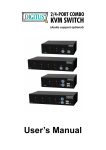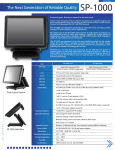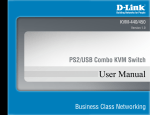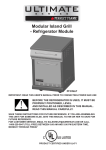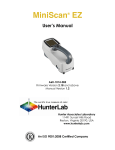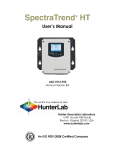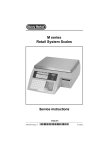Download USER¡¦S MANUAL
Transcript
8-Port / 16-Port KVM SWITCH User’s Manual Version 1.0 1. Introduction The 8-Port/16-Port KVM Switch are high quality and durable systems that will allow you to control 8/16 host computers (or servers) by connecting to PS/2 or USB connectors from one console (PS/2 / USB Mouse, PS/2 / USB Keyboard, and Monitor). Both KCF series and KCB series are with very similar design in hardware and user interface. The following table lists the basic configuration: Model KCF-1161S KCF-181S KCB-1161S KCB-181S 1.1 Number of PCs Support 16 PCs (w/h PS/2 & USB) 8 PCs (w/h PS/2 & USB) 16 PCs (w/h PS/2 & USB) 8 PCs (w/h PS/2 & USB) Console Port PS/2 & USB PS/2 & USB PS/2 PS/2 Difference Console USB No console USB Features Controls 8 / 16 computers from a single console (Keyboard/Mouse) over either PS/2 and/or USB connections The PC ports support Windows, Linux, Mac OS9/OSX, Sun Microsystems. Keyboard emulation on each un-selected PC to allow it to boot normally without a keyboard error Hot-swap support. All devices connected to the KVM switch can be added or removed at any time without shutting the unit down. On-Screen-Display (OSD) function provides an intuitive menu driven user interface for quick and efficient navigation. Cascade Chain function supports 3 level of cascading to expand the number of PC connections. Three level of switch cascading can control up to 64/256/4096 PCs, from a single console and no special configuration is required. Support 3 types of switching: (1) Hardware Push Button control, (2) Hot key command control from PS/2 or USB keyboard, (3) Menu driven OSD. Provide Auto-scan function to alternate video between computers in a preset interval sequentially by OSD. Provide LED display for PC status monitoring. Supports VGA resolutions up to 2048 x 1536. Provide Beeper during switching enabled. Fully compliant with the USB 1.1/ 2.0 specification Support 19” system rack mounting (1U height) 2/2 1.2 Package Contents The product package should contain the following equipment and accessories: 1 x 8-Port or 16-Port KVM Switch unit 1 x AC Power adapter 1 x Rack Mounting Kit Combo custom 4-in-1 cables (model dependent) 1 x Product CD (operation manual) 2. Specifications 2.1 General Specifications Specification Number Of Computers Controlled 8 / 16 PC Port Selection Method Push Button, Hot-Key (PS/2 or USB Keyboard), OSD LEDs Red for PC Selection Green for PC On-Line ready PC Connectors Video 2 / 4 x HDB -15 female ( VGA+USB+PS/2 signal combined ) Console Ports Keyboard KCF models - PS/2 mini-DIN + USB A type KCB models – PS/2 mini-DIN Mouse KCF models - PS/2 mini-DIN + USB A type KCB models – PS/2 mini-DIN Video 1 x HDB -15 female Auto-Scan Interval 5 ~ 250 Seconds (by OSD interface) DDC, DDC2 monitor Yes (Max. Resolution: 2048x1536) @ 85Hz Hot Swappable Yes Operating systems supported Windows 98SE/ME/2000/XP/2003 Server, Linux Mac OS9/OSX and Sun Micro System Device driver No Need Power By external Power Adapter +5VDC/2.4A Dimensions (L X W X H) 44 x 15.7 x 4.5 cm Unit Weight 8-Port : 1750g (17.3 x 6.1 x 1.5 inch ) 16-Port : 1900 g Housing material Metal Operating Temperature 32~ 122oF Humidity 0%~80%RH 3/3 (0~ 50oC ) 3. System Requirements Console A VGA, SVGA, Multisync monitor capable of the highest resolution. PS/2 and/or USB Keyboard/Mouse Computer or Server The following equipment must be equipped with each computer or server. - A VGA, SVGA or Multisync card. - Type A USB port or PS/2 6 pin mini-DIN for Keyboard and Mouse. Cables The KVM Switch must be used with specific combo 4-in-1 cables. To purchase more cable sets, contact your dealer. Figure 3-1 Combo 4-in-1 cable 4/4 4. Installation 4.1 Front View Figure 4-1 8-Port Models – KCB-181S, KCF-181S Figure 4-2 16-Port Models – KCB-1161S, KCF-1161S LED Display: Name Color Selected Red On-Line Green Function The PC port is selected. An active PC is connected. Reset Switch: Press this push button switch to reset the KVM device. To push the switch, use a ball-point pen or a small stick. PC Port Selection Push Buttons: The push buttons are used to select an associated PC connection manually. This is a kind of hardware type control for PC port switching. 5/5 4.2 Rear View Figure 4-3 KCB-181S Figure 4-4 KCF-181S Figure 4-5 KCB-1161S Figure 4-6 KCF-1161S Figure 4-7 Console Ports 6/6 4.3 Installation Precaution: 1. Make sure all devices are turned off when connecting to the KVM Switch. You must unplug the power cords of the computers which might have the Keyboard Power On function. Otherwise, the KVM switch will receive power from the computer. 2. When connecting Windows 98 systems, it is suggested that the PC must be plugged to PS/2 ports, because Windows 98 does not support installation at first time through USB HID installation driver. 3. Some old PCs can support USB ports during booting, but are required to open BIOS USB setting first. 4. The KVM switch does not support the USB keyboard which has built-in USB HUB. Figure 4-8 Console connections: Plug USB or PS/2 keyboard, USB or PS/2 mouse arbitrarily and VGA video into the Console ports located on the rear panel. A combination of USB mouse and PS/2 keyboard or a combination of PS/2 mouse and USB keyboard are all supported by the KVM Switch unit. System connections: Use KVM combo 4-in-1 cable (as shown in Figure 3-1) to connect an available KVM’s PC port to a computer’s video and USB or PS/2 ports (or even all USB and PS/2 ports of the PC). 7/7 This KVM Switch with specific combo cable provides three connecting methods. 1. Plug USB, PS/2 ( keyboard/mouse) ports and VGA into PCs at same time, recommended in priority. Figure 4-9 PS/2 & USB and VGA connected at same time 2. Plug only PS/2 (keyboard / mouse) ports and VGA into PCs. Figure 4-10 PS/2 and VGA connected 8/8 3. Plug only USB and VGA into PCs. Figure 4-11 USB and VGA connected 4.4 Cascading the KVM Switches For expansion of the PC connections, the switches support up to 3 levels of cascading between switches. The cascading function allows to control up to 64/256/4096 PCs from a single console and no special configuration is required. To cascade the switches, the steps are: 1. Make sure power of all connected devices are turned off before connecting. 2. Use the KVM combo 4-in-1 cables to connect the console port of a lower level switch to an available PC port of the upper level switch. This is called switch cascading. In switch cascading, make video HDB and two PS/2 connections only and no need to use USB connection. Up to three levels are supported in such cascading. The switch in the topest level is called Master KVM switch and others are called slave switches. The console port of the Master switch is the main console of all cascaded KVM switches. All free PC ports of Master KVM switch and the second level KVM Switches can still be used to connect PCs. 3. Plug in the power adapter to the Master KVM Switch and those PCs which are going to connect. And then plug in power adapters to the Slave KVM Switches in next level and the PCs sequently. 4. After all switches are up, power on the computers. 9/9 Initial Power-Up Process Power up the Master KVM Switch first before turning on other devices. Any powered-down computer and slave switches can be uplugged at any time after initial power up process completed. Hot plug and Hot Swap a) You can replace keyboard or mouse of the Master console port at any time without powering down the Master switch. b) Plug-in or unplug of PC port or swap PC ports can be done at any time without powering down the switches. Figure 4-12 Switch Cascading 10/10 4.5 Rack Mounting Figure 4-13 Installing the Brackets to the Switch Above figure illustrates how to install mounting brackets to the switch unit for standard 19-inch rack cabinet. The steps are: 1. Screw the mounting brackets onto both sides of the KVM switch unit. 2. Slide the switch unit into the rack cabinet and screw it securely on the rack. 11/11 5. Hotkey Operation The 8/16-Port KVM Switch has the ability to switch the keyboard, video, and mouse simultaneously. Note: If your keyboard does not provide < Scroll Lock > button, use < Caps Lock > as leading key instead. The default is < Scroll Lock >. Leading key Selection Hot key commands: [Ctrl] -> [Ctrl] -> [K] -> [Enter] to change current leading key to the other one After changing the leading hotkey setting, the new setting will take effect immediately until the KVM switch is powered off or reset. 5.1 Call OSD Menu Hot key command: [Scroll Lock] -> [Scroll Lock] -> [Enter] to call and show OSD “Main Menu” 5.2 Channel Select (Single KVM unit mode ) Hot key commands: [Scroll] -> [Scroll] -> [ n ] -> [Enter] to select PC channel n (n is a no. within 1~16) [Left Alt] -> [Left Alt] to shift and switch to next lower PC channel [Right Alt] -> [Right Alt] to shift and switch to next higher PC channel Note: The function of [Alt] to shift PC channel is disabled by default. Use the following command to enable the function: [Alt] -> [Alt] -> [Enter] to enable [Alt] shift PC channel function OSD Menu Use Up/Down arrow and <Enter> to switch the channel directly. 12/12 5.3 Auto-scan Function Hot key command: [Scroll] -> [Scroll] -> [S] -> [Enter] to start Auto-scan operation Under Auto-scan operation, you can press any key to stop Auto-scan operation. Auto-scan function allows the KVM Switch alternates the connected PCs and displays them on the console monitor. Each PC is displayed in a time interval in a range of 5 ~ 250 seconds (The interval is adjustable by OSD) before switching to the next PC. Pressing any key will stop the Auto-scan and the console monitor screen will jump back to the original PC. OSD Menu [F2] to start Auto-scan operation. Auto-scan time interval setting can be changed via OSD menu operation. 5.4 Beeper Enable Hot key commands: [Scroll] -> [Scroll] -> [B] -> [Enter] to disable Beeper [Scroll] -> [Scroll] -> [B] -> [Enter] to enable Beeper The Speaker/Beeper’s default setting is “Enable”. While the switching connections are activated and Speaker/Beeper is in “Enable” status, the beeper has a short beep. 13/13 5.5 Special Configuration Mode OSD Menu [F1] to enter configuration mode. No Hot key support. 5.6 Channel Select (Cascading mode) Hot key commands: [Scroll] -> [Scroll] -> [D][x] [D][y] [D][z] -> [Enter] to switch to PC channel on Layer 1 Channel x - [D][x], x is a number within 1 - 16 Layer 2 Channel y - [D][y], y is a number within 1 - 16 Layer 3 Channel z - [D][z], z is a number within 1 - 16 [Scroll] -> [Scroll] -> [D][x] [D][y] -> [Enter] to switch to PC channel on Layer 1 Channel x - [D][x], x is a number within 1 - 16 Layer 2 Channel y - [D][y], y is a number within 1 - 16 Layer 3 current (last) selected channel in the unit attached to Layer 2 channel y, (if 3 layers are setup). [Scroll] -> [Scroll] -> [D][x] -> [Enter] to switch to PC channel on Layer 1 Channel x - [D][x], x is a number within 1 - 16 Current selected channels in Layer 2 unit and Layer 3 attached to Layer 1 channel x. OSD Menu Select channel and press <Enter> layer by layer sequentially. 5.7 Console Lock Hot key commands: [Scroll] -> [Scroll] -> [H] -> [Enter] to lock console OSD Menu [F3] to lock console ( [F5]: Security mode must be ON first.) 5.8 Console Unlock Press any key to OSD unlock window. Enter correct User Name and Password to unlock console and be back to normal operation. 14/14 5.9 Hot-Key Definition Table Step 1 [Ctrl] + [Ctrl] [Scroll] + [Scroll] [Scroll] + [Scroll] [Left Alt] + [Left Alt] [Right Alt] + [Right Alt] [Alt] + [Alt] [Scroll] + [Scroll] Step 2 Function Change leading key of Hot-key command to the [K] + [ Enter ] other one (default: [Scroll]) [K] + [ Enter ] Change leading key to [Caps Lock] [n] + [ Enter ] Switch the active connection to PC n (single unit) Switch to next lower channel number Switch to next higher channel number [ Enter ] Enable [Alt] shift function [DxDyDz] + [ Enter ] Switch channel in 3 layer cascaded switches [Scroll] + [Scroll] [B] + [ Enter ] Toggle disable/enable beeper [Scroll] + [Scroll] [S] + [Enter] Toggle disable/enable Auto-Scan mode [Scroll] + [Scroll] [H] + [Enter] Enter into console lock mode 15/15 6. Sun Microsystems Function Key Emulation There are 16 special functions provided on Sun Microsystems keyboard. The KVM Switch can emulate those function keys on console’s PS/2 and USB keyboard. The following table lists the key mapping. To activate any emulation on the PS/2 or USB keyboard, press the LEFT Window KEY first (this key usually is located between the left [Ctrl] key and left [Alt] key), then press the second associated key. Sun Micro System Function Key PS/2 (or USB) Keyboard Stop L_Win & L_Alt Props L_Win & L_Ctrl Compose L_Win & L_Shift Front L_Win & F1 Open L_Win & F2 Find L_Win & F3 Again L_Win & F4 Undo L_Win & F5 Copy L_Win & F6 Paste L_Win & F7 Cut L_Win & F8 Help L_Win & F11 Power L_Win & F12 Mute L_Win & 1 Volume Down L_Win & 2 Volume UP L_Win & 3 16/16 7. OSD Operation 7.1 OSD (On-Screen-Display) Operation 1 2 3 4 5 6 Figure 7-1 OSD Administrator Menu Figure 7-2 OSD User Menu 17/17 7.2 OSD Main Menu Layout # in Figure 7-1 Function st KVM layer number: 1 , 2nd, 3rd PC name (configured by user): 31 characters max. PC Status (STA): Buzzer sound on Buzzer sound off L Locked port indication, and normal is blank Indicating the computer is powered on s Indicating the channel scan function is on Current selected channel 1 2 3 4 Cascade channel number: only display cascaded 2nd, 3rd layer selected channel number; if it’s in 1st layer, it will show blank. Page down-up indicator: (to next page) while connecting 16 port OSD KVM, it will show up & down arrows alternatively to select previous/next page’s port number. (Only for 16-port KVM only.) 5 6 7.3 OSD Main Menu Function Keys Key Function [Scroll] [Scroll] [Enter] ↑ ↓ [Enter] [PgDn] [PgUp] [Esc] S [F1] [F2] [F3] [F4] [F5] [F6] R Operation Pop-up OSD Main Menu Move to next lower channel and highlight it Move to next higher channel and highlight it Select Move to next channel page Move to previous channel page Exit OSD Scan Tag, set channel to be scan selected Set up: basic configuration menu Scan: Auto-scan function Logout / Lock: logout from console operation and enter into console lock mode. Rename: rename selected port name Security: security function and user priority setting Lock Port: PC port lock function (administrator only) Return to upper layer menu 18/18 Channel Status (STA) No sign S Indication A active computer is connected to the channel. No computer is connected or it is not powered. Selected for Auto-scan OSD Information Location in Menu Screen Channel No. Pink bar + 1st, 2nd, 3rd Number Top right corner Highlight in channel row list Indication Currently controlled channel Currently pointed channel A lower layer KVM switch is Front of a channel name row connected on this channel. Top left corner The layer number of this unit Upper left corner (below layer The selected channel number number) in upper layer switch 19/19 7.4 F1: Setup Mode Figure 7-3 OSD Setup Configuration Options Scan Mode Selected PC ON Scan Time 5 ~ 90 sec. Banner Time 5, 10, 15 sec. ∞ Menu Display Position Banner Hot-Key Sound Language Description Scroll Lock Caps Lock Ctrl ON OFF En De Fr Scan selected channels with STA status ”s” Scan all powered-on PC channels only Auto-scan time interval for each channel Default: 5 sec. Banner display time 5 sec., 10 sec., 15 sec. Default: 5 sec. Banner display always on Use arrow keys to move OSD main menu to the desired position Use arrow keys to move channel banner to the desired position [Scroll Lock] as leading key for Hot-key control [Caps Lock] as leading key for Hot-key control [Ctrl] as leading key for Hot-key control Beeper is enabled. Beeper is disabled. English Deutsch France 20/20 7.4.1 Position Adjustment Figure 7-4 Setup Position In banner display position mode, the display will become: When PC is powered on or changing channel by OSD or Hot-key, the banner will display for 5 seconds and disappear. User can configure the banner display time in the Setup Mode (F1). The following are different banner styles in different modes: Channel Banner ( In single layer ) (Max. 22 characters) ----- ------------------ | \__ \______________________ PC (Channel) Name Channel (PC) Number Channel Banner ( In cascading / Multi-layer ) (Max. 22 characters) ---- ---- ---- ---------------------- | | | | | \________________ | \_____________________ \_ \___________________________ PC (Channel) Name Channel (PC) Number 2nd Layer Channel (PC) Number 1st Layer Channel (PC) Number 21/21 Channel Banner (In scan mode) ---------- ---- ---------------------- | | \_ | \__________________ \________________________ PC (Channel) Name Channel (PC) Number Scan Mode Press any key to stop scan operation. Banner will disappear when the scan stops. 7.5 F4: Rename Figure 7-5 F4 Rename The New Name length is 31 characters Max. 22/22 7.6 F5: Security Mode The following message is prompted to enter password for security configuration: Entry Password: The default password for Admin is 123456. A correct password allows to enter Security configuration menu. Figure 7-6 F5 Security Configuration Only when Security mode is ON, F3 console lock function is enabled automatically and Hot-key [H] lock command also becomes available at the same time. Pressing F3 or Hot-key [H] command allows to lock console as logout from the console until a correct username and password are entered. Only administrator is allowed to unlock the console. But, the access right to a connected PC is limited to the user PC authorization configuration. Different users have different rights to the channels. 23/23 To change Administrator Password: Figure 7-7 Change Admin Password To change User Name and Password: Figure 7-8 Change User Name and Password 24/24 To configure User PC Channel Authorization Setting: Figure 7-9 PC Channel Authorization Setup 7.7 F6: Lock Port Figure 7-10 Lock Port Setup Press F6 to set currently highlighted channel locked. The locked channel is with a “L” mark in its STA column. Press F6 again and enter a correct password to unlock to channel. 25/25 7.8 F3: Console Lock / Logout Press F3 to lock console (Security mode must be ON.). The console devices and KVM buttons are locked with no function. The following banner is displayed when console is locked. Only correct password is accepted on the keyboard. F3 Console Lock Mode Banner To unlock the console, press any key to the Unlock Window as shown below: Unlock Window Then, enter User Name and Password to unlock the console. The screen will be back to normal and all devices are available to operate again (according to the authorization setting). Note: If you forget the password, the only way to resolve the security mode is to enter an universal password to unlock KVM and restart everything. Consult your dealer for the universal password. 26/26 8. Troubleshooting Symptom Keyboard and/or Mouse not working Possible Cause Keyboard and/or Mouse need to be reset. Failed connection to the computer. Recommended Solution To unplug from console port(s), and then replug it / them into console in. Check the cable connected from switch to computer and make sure it is connected properly. KVM Switch needs to be reset. Power off all devices and then power up again. Master/ Slave cascading not working Incorrect configuration or improper installation procedures Double OSD images in cascaded mode Improper slave connection procedure. Make sure the console of the Slave’s connected to Master’s PC port. Remove any possible power supplies to the slave ( unplug all cables), before connecting it to the Master. Remove any possible power supply to the Slave ( unplug all cables), before connecting it to the Master. Make sure cable is connected well (Slave console link to Master port). Use <F1>: Set/Position to move OSD menu and banner to a proper position. Failed connection OSD menu is not at the proper position OSD menu has fixed resolution and its size varies due to the changes of computer VGA resolution 27/27 Disclaimer Information in this document is subject to change without notice. The manufacturer does not make any representations or warranties (implied or otherwise) regarding the accuracy and completeness of this document and shall in no event be liable for any loss of profit or any other commercial damage, including but not limited to special, incidental, consequential, or other damages. No part of this document may be reproduced or transmitted in any form by any means, electronic or mechanical, including photocopying, recording or information recording and retrieval systems without the express written permission of the manufacturer. All brand names and product names used in this document are trademarks, or registered trademarks of their respective holders. FCC Statement This device generates and uses radio frequency and may cause interference to radio and television reception if not installed and used properly. This has been tested and found to comply with the limits of a Class B computing device in accordance with the specifications in Part 15 of the FCC Rules. These specifications are designed to provide reasonable protection against such interference in a residential installation. However, there is no guarantee that interference will not occur in a particular installation. If this device does cause harmful interference to radio or television reception, which can be determined by plugging the device in and out, the user can try to correct the interference by one or more of the following measures: Reorient or relocate the receiving antenna. Increase the separation between the device and receiver. Connect the computer into an outlet on a circuit different from that to which the receiver is connected. Consult the dealer or an experienced radio/TV technician for help. 28/28




























